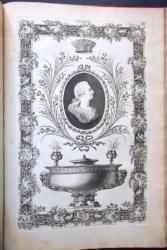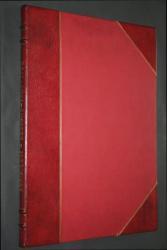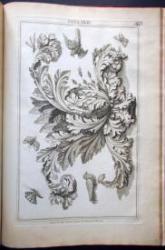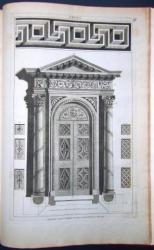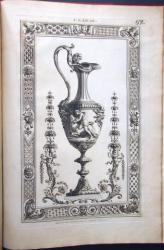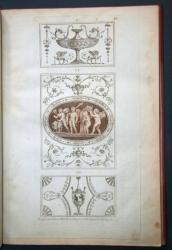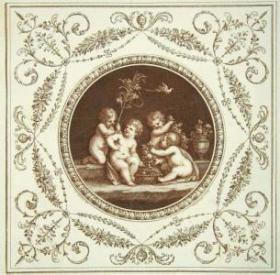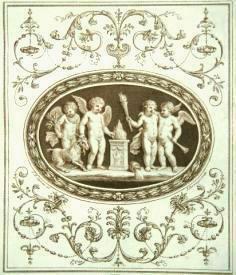www.gauntantik.com
PERGOLESI, Michel Angelo
[A Great Variety of Original Designs of Vases, Figures, Medalions, Frizes, Pilasters, Pannels and other Ornaments, In the Etruscan and Grotesque Style]
[London]: [plates dated 1777-1792]
First edition, a complete lifetime collection with prospectus. Broadsheets, 68 leaves (62 leaves 53.6 x 36.8 cm; 5 leaves ca. 52.5 x 34.5 cm, irregular; 1 leaf “Proposals” 37.5 x 23 cm, laid down). Engraved dedication, 2 engraved portrait plates and 59 etched plates printed in bistre or black on full sheets, 5 etched and engraved plates, the engravings printed in sepia, on smaller sheets with top edges flush, others irregularly cut or deckle, “Proposals” for the work printed on grey laid paper and annotated in ink by Pergolesi, mounted onto full sheet of old wove. Burgundy half morocco and crimson bookcloth by Sangorski & Sutcliffe (its stamp lower front pastedown), spine with four raised bands and bold gilt block lettering, spine and covers with double gilt rules, all flush edges with old gilt, light blue-grey patterned endpapers. Collates 68 ll. (“Proposals” followed by 67 plates numbered 1 to 66, two numbered 56) plus [2 ll.] endpapers and binder’s blanks front and rear, the plates printed on “Superfine Imperial” paper (so-called in the “Proposals”: Dutch laid paper with various “I.V.” watermarks, several similar to Heawood 1843; plate 66 on wove paper); plates 41 through 65 on paper with pale blue-grey tone (other than plates 51 and 55, printed with sepia, and plate 66, on ivory wove). In very good overall condition; slight nicks to cover bookcloth, light dampstaining to margins of opening and closing plates and in lower gutter area of plates 51-60, two restored tears in lower margin plate 51, crinkling and small hole on plate 54, other scattered staining, creasing, small tears and paper defects; the text block with old gilt edges probably assembled at an early date, subsequently rebound by Sangorski & Sutcliffe; a bright set, the text block with ample margins, tight and well preserved.
In his Proposals (prospectus for subscriptions) Pergolesi says that he “has had the Honour of Designing and Painting Rooms, Ceilings, Stair-cases and Ornaments, for several of the Nobility and Gentry in England.” We know of his work under Robert Adam for the Duke of Northumberland at Syon House in Middlesex and for Sir William Chambers at Gower House in Whitehall. The present work indeed spreads out his “Rooms, Ceilings, Stair-cases and Ornaments” for the enticement of prospective clients, with a certain repetitive cycle of patterns, ornate inventions, grand ceilings and architectural elevations and sections, selected plates featuring engraved medallions signed by, or ascribed by Pergolesi’s Proposals to, Francesco Bartolozzi after Giovanni Battista Cipriani. Pergolesi’s self-promotion was, nevertheless, one of the seminal vehicles for the expansion of the “Adamitic mode” (Walpole’s phrase), so much that John Aldam Heaton (Furniture and Decoration in England during the Eighteenth Century, 1892) considered that Pergolesi was the draughtsman if not the actual designer of the “Ornament” contained in The Works in Architecture of Robert and James Adam (1773-9). Indeed, in its 1982 exhibition of Adam style, the Cooper-Hewitt Museum featured, among 135 entries of drawings in the exhibition, almost invariably ascribed to the Adam brothers themselves, its own album of Pergolesi drawings from 1776-7 (in the same style as the first plates in the present set). As Professor Maser writes in his introduction to the Dover reprint of this volume (op. cit., p. vii), “Nowhere in the repertoire of ancient art will one find the exact counterparts of Pergolesi’s or Adam’s inventions, let alone their applications, so that their designs cannot be called imitations. They derived their patterns from classical prototypes, but their use of these models was still a very uninhibited and imaginative one, and, happily, of great influence. The entire field of interior and furniture design of the period of George III and the early Regency in England, as well as that of the Louis XVI period in France, owes its lightness and elegance of line and its simplification of form to designs such as these.”
The publication history of this work may be gleaned from the dating of the plates and the successive Proposals issued by Pergolesi to prospective subscribers. The copy of the Proposals laid into the present volume states, before manuscript amendments, that 13 numbers of five plates apiece, “dedicated, by permission, to his Grace the Duke of Northumberland,” and “With several Pieces drawn by the late renowned Mr. J. B. Cipriani, Esq; R.A.and engraved by the celebrated Mr. F. Bartolozzi, Esq; R.A.,” will be published by subscriptions taken at the Author’s and by P[atrick] Byrne, Bookseller, No. 108, Grafton-street (Dublin). This issue of the printed Proposals, therefore, postdates the death of Cipriani on December 14, 1785 and antedates the death of the Duke on June 6, 1786. It promises that Pergolesi “will have” 11 of the 13 numbers available for subscribers requiring immediate delivery, at a price of six shillings per number, to which “will be annexed several beautiful Drawings and Engravings, by the said Messrs. Cipriani and Bartolozzi [specifying seven, of which five bear signatures].” The last sentence of the Proposals states: “A List of the Subscribers Names will be engraved with the last Number, with the Title, Dedication, and Index of the Work, in English, French, Italian, and German: With an elegant Portrait of his Grace the Duke of Northumberland, engraved by the aforesaid F. Bartolozzi, Esq; R.A.” The manuscript alterations to these Proposals expand the project to thirteen “or sixtin” numbers, delete “will” (twice) to make immediate the offer of delivery of 11 numbers, add to the seven etchings which are credited to Cipriani and Bartolozzi in the first 11 numbers, “and the last No. a Beautiful engraving of Semmer by ditto and ditto,” delete bookseller Patrick Byrne’s name and address (divorcing Pergolesi henceforth from any bookseller alliance), and give warning, “and no renewells. – after dis volum will commince a Second v.” Accordingly, sometime between December 1785 and June 1786 Pergolesi was self-publishing sets of 11 numbers with solicitations of subscriptions for five future numbers.
Four of the five plates in the 11th number are dated March 20, 1785; one is dated November 1, 1784. In the present set, however, the publication dates in most of the first three numbers have been reset forward from 1777 and 1778 to 1787 by ink or scratch engraving alterations to digits of the year, possibly to extend copyright; thus, in the examples revised furthest forward, four plates in the second number are redated from 1st September 1777 to 17“8”7. This particular instance of redating (which the Millard catalogue notes differently in another copy) might suggest that the purchaser of this copy may have received the Proposals laid into this copy in the first half of 1786 but the first 11 numbers later in 1787.
The plan for a second volume, with 20 numbers in each volume still at 6s. each number, is set out in the later version of the Proposals included in the Millard copy and illustrated on p. 205 of the Millard catalogue (op. cit.), dated “London, 178” at upper right subsequent to the death of the “late” Duke and still promising in the last number the title, dedication and index and an “elegant Engraving of his Grace the late Duke of Northumberland, designed and engraved by the said Messrs. Cipriani and Bartolozzi.” The 12th number was finally launched in 1791 with plates 56 (the dedication to the Duke) and 56 bis (the portrait of the Duke “Drawn by P[ierre] Violet. Engraved by I[gnatius] I[oseph] Van den Berghe”), both dated July 26, 1791 (the portrait date altered in pen to 179“2” in the present copy), and the other four plates in the number dated April 1791 (but all revised forward to 179“2”).
At this juncture the prospective scope of the project was expanded yet again, to two volumes of 24 numbers each. A small announcement laid into the Millard copy, confirmed by a still later version of the Proposals cited by Harris (op. cit.; the Morgan Library 12-fascicule copy 78159 has one dated 17”94”), states that “the next Number, being the 13th, as well as the succeeding Numbers to No. XXIV. the whole Numbers of the first Volume, will have one Plate each, additional; the Price will be 7s. 6d. each Number, including a Dedication (by Permission) and a Portrait of the Noblemen or Gentleman to whom the Number is dedicated.” The 13th number included one plate dated April 1791 (revised forward to 179“2” in the present copy) and four dated February 1792 and concluded with plate 66, dated August 30, 1792, dedicating the number to Elizabeth Duchess of Buccleuch, “Encourager of the Artists.” The alteration of the date on the portrait of the Duke (plate 56 bis) and the four design plates in the 12th number suggests that its publication may have been delayed some months into mid-summer 1792, possibly while Pergolesi sought out patronage for the 13th number. The substitution of Bartolozzi’s friend Violet and pupil van den Berghe in the execution of the Duke’s portrait, rather than the originally promised Cipriani and Bartolozzi, may indicate a diminution of the resources of the project (although Cipriani was long dead).
The plates of the 12th and 13th numbers were the last published by Pergolesi. Plates 66 bis and plates 67-70, etched by others, were published posthumously in 1801 by “M. Dulauchamp [also “Dulonchamp” and “Dulouchamp”], Bookseller, Successor to the late Signor Pergolesi”; no further number was ever published; and the promised subscribers’ list, title and index, and the plate of “Summer” by Bartolozzi after Cipriani to complete the series of the Seasons, were never issued.
In the present set the engraved dedication to the Duke, plate 56, is on thinner, not quite opaque, laid paper with a much more pronounced pale blue tone than the quite pale, perhaps faded blue tone which appears on other plates of this set between plates 41 and 65 (except 51 and 55). The “blued” paper for these plates, intended as a correction to the yellowish color imbalance of cream-colored paper, was a papermaking innovation of the later 18th century. It should be noted that the drawings for these plates, bound as a volume in the Morgan Library’s B3 044 A02, are generally in brown-toned ink on blue-grey laid paper, and a proof engraving of plate 38, inserted in place of a drawing in the Morgan’s volume, is likewise on blue-grey paper. Indeed, the Millard catalogue, op. cit., p. 206, states that plates 56-65 in the Millard copy are “part of a special issue printed on blue paper.” The extent of the inclusion of blued paper provides a clue to the printing history of a given set. The 67-plate set 46.50.2 in the Metropolitan Museum of Art follows the present set with plates 41-65 on blued paper; whereas the incomplete 10-fascicule set at the New York Public Library and 6-fascicule Palmer set at the Metropolitan Museum have no blued paper, and the first 67 plates of the later-printed Morgan Library copy 55778 with 72 plates (postdating Pergolesi’s death) are almost entirely on uniform blued paper.
Whether or not the inclusion of “blued” paper in Pergolesi’s sets rises to the level of “special” copies, the present copy has five plates (10, 20, 30, 40, 55) on slightly smaller deckle-edge sheets with deep sepia printing of the Cipriani - Bartolozzi central medallions. Additionally, plate 51 is strongly printed in a sepia tone similar to that of the engraving of “Winter” on plate 55; these plates are not on blued paper like the adjoining plates. The sepia ink is distinctly redder than the mostly brown-black (“bistre”) ink of the remaining plates and reflects the reddish tone which Pergolesi favored in some of his own drawings in the Morgan Library’s drawings volume (which has blank spaces for the Cipriani – Bartolozzi contributions). The present set may perhaps have been “special’ in this regard; only one plate in the Metropolitan Museum’s 67-plate set, and no plate in either of the Morgan Library’s printed sets, has sepia printing of the central medallions.
Finally, the Morgan Library’s 12-fascicule set, uncut and stab-stitched into mostly original strawberry-hued paper wraps, establishes that the uncut size of this set is 54 x 39 cm. The 67-plate set in the Metropolitan Museum (annotated, doubtlessly by a bookseller, “large paper very rare”) has plates 53.0 x 35.5 cm; the plates of the Morgan Library’s 72-plate set are 54 x 36.5 cm. Thus, the present set, its plates 53.6 x 36.8 cm, has as large margins as can be expected in any bound set; the edges, preserving their old gilt, were not cut down further in the present sympathetic binding by Sangorski & Sutcliffe.
Provenance:
Richard Harris (Riverwoods, Illinois)
References:
Cooper-Hewitt Museum, exhibition catalogue, Robert Adam & His Style: City Dwellings and Country Houses (New York: Cooper-Hewitt Museum, 1982).
Harris, Eileen (with Nicholas Savage), British Architectural Books and Writers 1556-1785 (Cambridge and New York: Cambridge University Press, 1990), no. 699, p. 368.
Harris, John, A catalogue of British drawings for architecture, decoration, sculpture and landscape gardening, 1550-1900, in American collections (Upper Saddle River, N.J.: Gregg Press, 1971), p. 156 and pl. 113.
Maser, Edward A., introduction, Classical Ornament of the Eighteenth Century Designed & Engraved by Michelangelo Pergolesi (New York: Dover Publications, 1970), pp. v-vii.
National Gallery of Art, The Mark J. Millard Architectural Collection (Washington: National Gallery of Art; New York: George Braziller, 1993-2000), vol. II, British Books: Seventeenth through Nineteenth Centuries (1998), no. 55, pp. 204-6.
